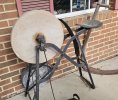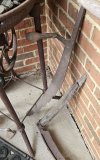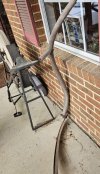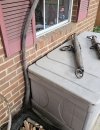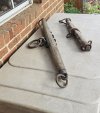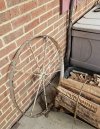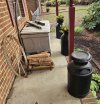- Joined
- Sep 29, 2015
- Messages
- 491
I don’t think I’ve ever shown this on here yet. Maybe 5 years ago now my dad found this old treadle wheel for sale in North Jersey. Was super cheap and the stone was in pretty good shape. The wheel was bought new by the seller’s grandpa who used it, then sat in his basement for decades (maybe anlmost a century at this point) until I bought it. There is a medium sized chip on the stone that he remembered causing when he was little. And some signs of someone trying to take it apart to fix some things.
The “things” someone was probably trying to fix are that the right side ball bearing socket (the one the original pedal bar is attached to) is bent. Have some comparison shots of the left side (the one with a cable me and my dad had to rig up).
And of course the bolt that holds the bent side in place is broken off and it looks like someone then tried to beat that side off the axel with a hammer.
The bend is enough that whenever the right side (bent side) pedal get to its highest point in its cycle, it causes the wheel to twist to the right slightly.
I use the wheel a bit for sharpening machetes and axes. It makes a really nice toothy edge and is surprisingly easy to use. I’ve been wanting to use it for the primary bevels on the kiridashi I make but the wheel twisting every half turn makes them come out too uneven. I’m considering making a tool rest I can clamp onto the body when I’m doing primary bevels but want to fix the twisting/tilting issue first.
What’s my best way of going about getting that bent side disassembled so I can straighten it out? I have a tap and die set (never used it before), a small flux core welder, and an Ace hardware half a mile from my house. So I’m sure we can figure something out with what I’ve got on hand. I just don’t want to go damaging any of the parts more than whoever tried before.
Kevin
The “things” someone was probably trying to fix are that the right side ball bearing socket (the one the original pedal bar is attached to) is bent. Have some comparison shots of the left side (the one with a cable me and my dad had to rig up).
And of course the bolt that holds the bent side in place is broken off and it looks like someone then tried to beat that side off the axel with a hammer.
The bend is enough that whenever the right side (bent side) pedal get to its highest point in its cycle, it causes the wheel to twist to the right slightly.
I use the wheel a bit for sharpening machetes and axes. It makes a really nice toothy edge and is surprisingly easy to use. I’ve been wanting to use it for the primary bevels on the kiridashi I make but the wheel twisting every half turn makes them come out too uneven. I’m considering making a tool rest I can clamp onto the body when I’m doing primary bevels but want to fix the twisting/tilting issue first.
What’s my best way of going about getting that bent side disassembled so I can straighten it out? I have a tap and die set (never used it before), a small flux core welder, and an Ace hardware half a mile from my house. So I’m sure we can figure something out with what I’ve got on hand. I just don’t want to go damaging any of the parts more than whoever tried before.
Kevin

